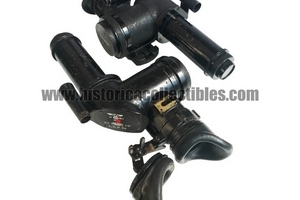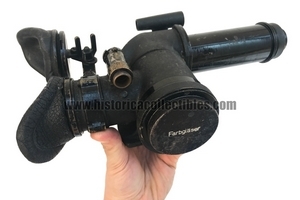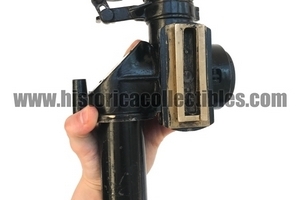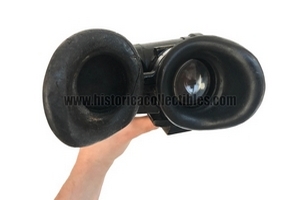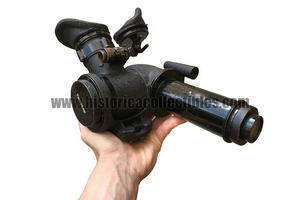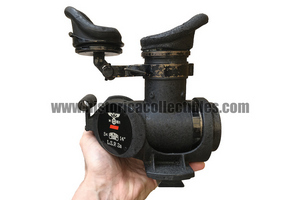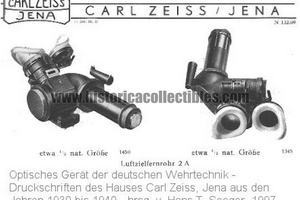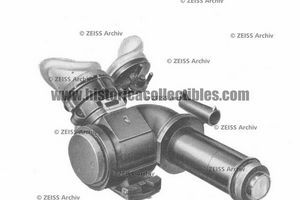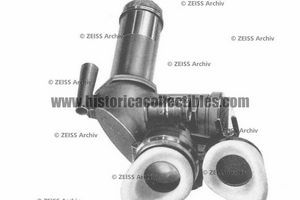Luftzielfernrohr L.Z.F. 2A 5x-14° Carl Zeiss, Kriegsmarine, circa 1939
Luftzielfernrohr model L.Z.F. 2A 5x-14°, produced by Carl Zeiss in around 1939, to be used as an aiming sight on large caliber machine guns and 75 mm cannons of the Kriegsmarine for direct fire against aircraft.
The objective part can be tilted up to + 90° and at 1000 meters it guarantees a field of view of 245 meters.
It is completely made of solid bronze and its structure is designed to resist not only indirect water and bad weather, but also the great forces resulting from cannon fire.
It is equipped with 3 colored filters as well as an aiming reticle.
All mechanisms work correctly and smoothly and the view is excellent.
Its weight is 4.2 kg.
Carl Zeiss Jena Archiv:
The rifle scope is intended for anti-aircraft guns to engage air targets in direct fire. Shooting at sea and land targets is also possible. The viewing port is arranged parallel to the viewing plane with an inclination of 30° to the swallow and offset to the side by 56 mm to the viewing area.
The beam path is therefore deflected twice by 90° each. So that the viewing direction and the gunner's posture always remain the same when shooting against air targets at all elevation angles up to 90°, the viewing port is arranged to be rotatable in the elevation direction in relation to the viewing port and the latter is firmly connected to the mount.
The viewing port stored in the carriage is adjusted relative to the fixed viewing port according to the elevation angle of the gun barrel as well as the attachment angle and elevation angle allowance, and thus the view in the elevation direction is adjusted accordingly.
Thanks to a built-in elevation system, the image of the target remains vertical at all elevation angles. The magnification is 5x. The field of view is 14°. The weight of the telescope is 4.2 kg.
Carl Zeiss takes its name from its founder, Carl Zeiss, who on November 17, 1846 chose the small city of Jena, in Thuringia, as the location for his precision optical equipment factory. Thanks to the strict quality control that Carl Zeiss imposed on its products, going so far as to personally destroy the microscopes that did not pass the tests, the newborn Zeiss became the official supplier of the University of Jena and received the gold medal of the industrial exhibition in 1861 of Thuringia as the best research instrument produced in Germany, awarded to the Stand I microscope of 1857.
In 1866 the thousandth microscope was produced and the name Zeiss became known throughout European scientific circles. Thanks to studies on the Porro prism, in 1893 Abbe patented double prism binoculars, which accentuated the perception of depth. The mass production of Zeiss binoculars began in 1894, already at the beginning of the twentieth century more than 30,000 were made, by the beginning of the First World War the figure had risen to 500,000 and, by the end of the Second World War, 2,260,000 were produced binoculars for the civil and military market. Models were made starting from 4x11 mm to 12x40 mm, up to real giants such as the 80 mm and 100 mm. Thanks to studies conducted on the perception of light in low light situations, it was shown that the average dilation of the pupil in an adult is about 7 mm. For this reason, the 7x50 mm model was introduced in 1910 and remained on the market until 1917 with few changes to the materials used.
In 1926, following the post-war crisis of the First World War with the Treaty of Versailles which bankrupted many important German companies, Zeiss bought the "C.P. GOERZ" and founded the Zeiss Ikon in 1926. In 1937 Zeiss had commercial contacts and factories in more than 29 countries around the world. From '33 Zeiss acquired interest from the Nazi regime, which balanced production towards military instruments. It successfully produced binoculars with wide-angle optics for military use, pressure resistant optical systems for U-boats, periscope binoculars for targeting tanks. Furthermore, Zeiss cameras were mounted on the V2s for remote sensing operations of the English coasts.
On November 1, 1935, Zeiss, in the person of Alexander Smakula, patented a process for the treatment of optical glasses with extraordinary results in terms of light transmission. Remained a military secret until 1939, it was adopted on binoculars to reduce ghost images and internal reflections. During the Second World War, there were numerous bombings against the Zeiss factories. Jena was bombed several times by the Allies starting in 1944. Stuttgart was razed to the ground, although the Contessa-Nettel factory suffered little damage. The bombing of Dresden, in addition to devastating the city, also caused considerable damage to the Zeiss Ikon headquarters.
On April 13, 1945, American military forces entered Jena, surprising themselves that the bombing had not caused any significant damage. The main planetarium was in ruins, while the factories remained operational.

